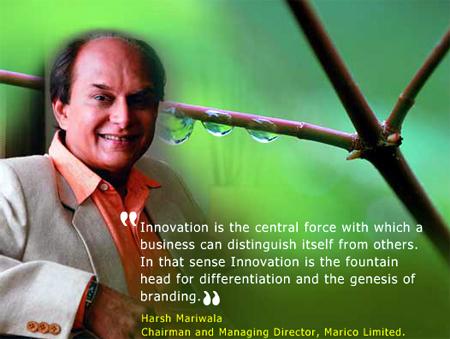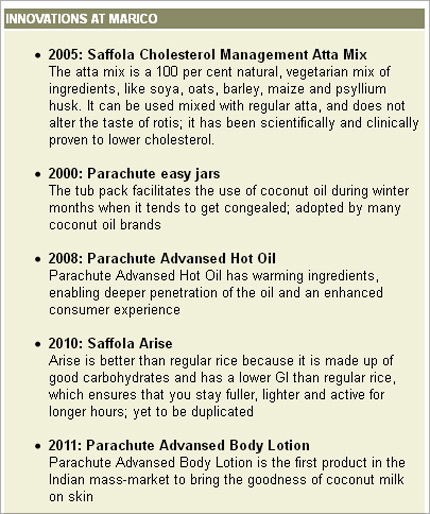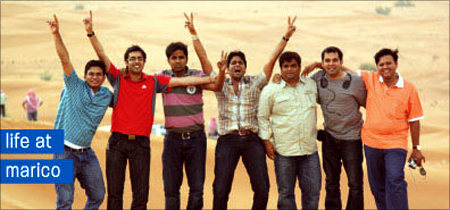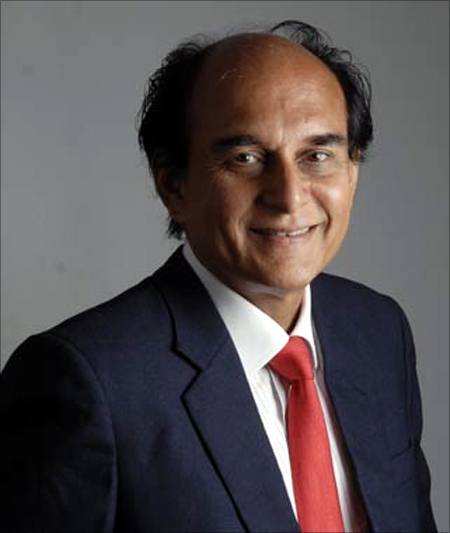Photographs: Courtesy, Marico. Sayantani Kar
In a recent conversation with Sayantani Kar, Harsh Mariwala said innovation is as much about encouraging new ideas as about rigorous follow-through.
The Little Black Book of Innovation defines innovation as "Something different that has impact". So do you believe in defining innovation, unlike many others who leave it vague?
We have not defined innovation within the organisation. I am not one for too many definitions. I am all for practical measures, which have an impact.
Innovation for me is anything unique that creates value. It could create value for a customer, for employees, any stakeholder or even for the society. So, it need not always be a new product.
...
Innovation is the success mantra at Marico
A recent Wall Street Journal article claimed that the term innovation has become a cliche and how many companies are using the term innovation to denote growth when there is none. How do companies identify what is innovation and differentiate the disruptive ones from changes such as efficiency improvements and those that come out of regular progress in business?
Efficiency improvements would mostly be through benchmarking and not so much through innovation. Innovation has to be something that you have done for the first time on your own.
There are three kinds of innovation. One is that, which has an impact on existing core business activities, the other is change in areas adjacent to the core businesses that exist and the third is, of course, disruptive innovation. The first two are easier to achieve.
For example, the change from tin to plastic packaging for coconut oil was an innovation related to the core of our business.
...
Innovation is the success mantra at Marico
Image: Saffola Oats.While for Saffola Oats, we did an adjacency innovation with a variant called 'masala' oats. It had not been tried before and yet was not a completely different from what we already had.
I don't think we can claim any disruptive innovation, but something like the Tata Nano car would be surely one of those.
Such innovation is transformational but requires a completely different approach.
It is more difficult to achieve and requires dedicated teams, and yet, at times, you might not get a result. It is like a pharma company coming out with a new molecule. There needs to be a strong belief that it will work.
...
Innovation is the success mantra at Marico
Image: Kaya Clinic.Where have you seen innovation stemming from? Does it emerge from labs only?
I have seen innovation emerge from different needs, starting from business models, human resources to finance. For Kaya, we innovated the business model.
To reduce our fixed costs, we now rotate staff between clinics in a city, depending on load of appointments at the clinics.
It helped reduce our fixed costs since we deployed the existing staff more efficiently across clinics in a city.
Similarly, in administration, we have innovations such as the absence of a roster whereby employees can fill up their own leaves as and when they need.
Travel for work does not need authorisation and can be claimed by the one travelling. Such measures tend to build up trust.
...
Innovation is the success mantra at Marico
Image: Innovations at Marico.Do such measures foster innovation?
They say, 'the organisation trusts me'. The employee then has a better equation with the employer, which ends up creating value. Indian employees have often complain-ed that they feel hierarchical firms are the biggest barrier to innovation.
We have tried to break down hierarchies. Right from the way the office is designed to the number of levels within the organisation. There is fast communication and a high degree of informality.
In the past, a lot of business ideas would take a lot of time in getting cleared. But then we formed an incubation cell.
This creates a small-company culture in a large organisation. We tried this when we wanted to create a new profit centre. Earlier, new business ideas would get passed on to existing CEOs, who already had the daily responsibilities of their businesses.
...
Innovation is the success mantra at Marico
Image: Kaya Clinic products.Then the new ideas would get evaluated through that same lens needed to run a business daily. So, by the time an idea got evaluated, there would be a huge delay.
Incubation cells, on the other hand, consist of one or two people who report directly to me and treat me like a small entrepreneur, bypassing the regular clearing processes when researching new ideas.
In this case, I, as an entrepreneur, took the risk, did the quick and dirty market research and took the call to float the initiative. Because of such an incubation cell, the idea of laser hair removal came about and the Kaya Skin Clinic was launched within nine months.
The normal process would have taken two to three years at least. Incubation cells are project-based and are not a regular feature.
...
Innovation is the success mantra at Marico
You institutionalised innovation in the early 90s at Marico, but have been practising it since the 70s, when you joined the business at Bombay Oil Industries. Have you seen the nature of innovation changing over the years?
In the 70s, innovation was more of an accident, and lacked structure. Today, it is through a culture of encouragement. The biggest change has been this culture where initiatives to encourage an innovative streak has been institutionalised.
Another important ingredient of change has been the top management's role in reinforcing innovation on a perpetual basis.
...
Innovation is the success mantra at Marico
Image: Courtesy, smude.edu.in.If innovation is a discipline and not a sudden epiphany, what are the main practices of the discipline?
A coordinated approach to innovation, covering products and processes is the mainstay. The culture for innovation is one where people are encouraged to take risks, to go outside their routine mandate.
There could be internal facilitators, conducting workshops - people who will get a group to think differently. Or an external innovation consultant could also help.
The top management would have to regularly review what is happening; for instance creating an innovation agenda for every brand.
...
Innovation is the success mantra at Marico
Photographs: Courtesy, inclusive-solutions.com.
If they keep a tab in this manner, then the teams automatically think along these lines. So the top management will need to go on reinforcing the need for innovation.
To encourage this culture, there could be training programmes, facilitation, rewards and recognition that are shared with everyone in the organisation.
Ideas could get generated through brainstorming sessions, dialogues, review meetings, customer feedback. That is when execution takes over.
...
Innovation is the success mantra at Marico
How does one avoid the trap of innovation becoming just another leadership programme or consultant technique?
The key is to go on demanding innovation and make sure that it happens. In our case, we have an internal award for which we get 30-40 entries every year.
These are either in product development, processes, packaging or marketing. The fact that so many ideas come up and are worked on shows that innovation has not become cliched.
Of course, these ideas then lead to evaluation, implementation, and prototyping. Innovation is not just about creativity but also about execution.
...
Innovation is the success mantra at Marico
Scaling up and execution remain the biggest hurdles...
People underestimate execution. You need to have rigour in execution. At one level, rigour and creativity don't go hand in hand. That is the key challenge.
Once you are done conceptualising, then rigour should take over. That would mean delegating and setting up timeframes, consumer tracks and review mechanisms. You have to persist with the execution, too.
We took eight to 10 years to get the traders accept coconut oil in plastic bottles instead of tin. We could do that because we were confident it was not only cheaper to make but also easy to use.
...
Innovation is the success mantra at Marico
How are the teams put together for innovation? It has been observed that the best innovations are created by teams with complementary skills, such as a Wozniak to a Jobs...
That is the problem - a lot of people think that innovation happens by design, whereas a lot of it happens by accident. Everything need not be planned.
A lot happens through dialogue, deliberations and training programmes. Identifying an idea can be an accident. But having identified it, one needs to put up a team comprising marketing, product development, supply chain for a coordinated approach.
How do you encourage and retain the people who take those chances on innovation?
The top management should not be very specific in measuring innovation. They should have an exploratory mindset, and accept ambiguity and some bit of chaos. Else, the culture will turn into a risk-averse one.














article